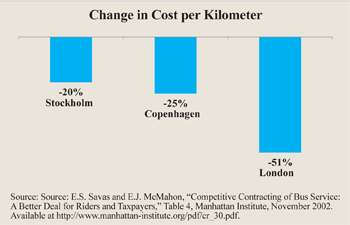Our nation has gone to great lengths to protect people from private monopolies through the Sherman and Clayton Antitrust Acts, the Justice Department’s antitrust unit, and public service commissions that regulate utilities in every state. All this effort is directed against the actions of privately owned companies that would like to raise their prices and increase their profits.
But monopolies where the government is the sole provider of a particular good or service and competition is prohibited by law favor their own interests, just as private monopolies do.
The antidote to monopolies, including public-sector ones, is competition. Not all public services lend themselves to it, but we should opt for competitive contracting wherever possible. One viable area is bus services, where competition would help break up inefficient transit monopolies. With more than 2 million daily riders — the most in the country — New York is a city that would especially benefit from privatizing its bus system.
 Privatization Reduces Costs. In order to reduce its budget gap, New York’s Metropolitan Transportation Authority (MTA) has dropped more than 30 bus routes, 500 bus stops and two subway lines in recent years.
Privatization Reduces Costs. In order to reduce its budget gap, New York’s Metropolitan Transportation Authority (MTA) has dropped more than 30 bus routes, 500 bus stops and two subway lines in recent years.
Major cities such Los Angeles, San Diego, Stockholm, London and Copenhagen introduced bus competition several decades ago and were spectacularly successful in reducing costs without negatively affecting service. Indeed, savings ranged from 20 percent to 51 percent in cities that used competitive bidding to select bus contractors, according to a Manhattan Institute study. Specifically, after privatizing its bus service [see the figure]:
- Stockholm’s cost per kilometer for bus operations dropped 20 percent from 1991 to 1999.
- Copenhagen’s cost per kilometer dropped 25 percent from 1989 to 1999.
- London’s cost per kilometer dropped 51 percent from 1985 to 2000.
Even a 20 percent cut in costs would save New York close to $500 million a year — enough to restore many dropped routes.
Breaking up the Bus Monopoly. New York squandered a valuable opportunity in 2005 and 2006 when it took private companies that enjoyed exclusive, noncompetitive deals with the city to provide bus service and merged them with the state-run MTA, instead of bidding out their routes in a truly competitive process. To this day, competitive contracting is practically verboten among public officials, who cower before the transit unions’ political might.
Still, private carriers, regulated by the city, are emerging to serve to public’s transit needs in areas abandoned by the MTA. Newly deregulated commuter vans operate along former MTA routes in Brooklyn and Queens; a new group-ride taxi runs from the Upper East Side to the Financial District; and a small private bus company will initiate service along three dropped express routes into lower Manhattan.
The economics are an eye-opener:
- It cost the MTA $19 per passenger on one of these bus routes, but the fare was $5.50 — with taxpayers subsidizing the rest.
- The private transit company expects to make a profit charging the same $5.50 with no subsidy.
- This illustrates the huge cost disparity between public and private operation; if the entrepreneur is right, he will cut costs by 71 percent.
Transition to Competition. Competition for bus service should be introduced gradually. Beginning in one borough, existing bus routes could be divided into several logically related route clusters of similar size. The MTA could continue to operate most of the clusters, at least initially, with just two or three put out to competitive bid for staggered three- to five-year contracts. In the contract specifications, the MTA would set the daily bus schedule for each route in each cluster and also calculate its own current cost of operating that cluster. The MTA could invite bids from qualified private bus operators and compare the bids with current costs. If a bid price is lower, the state would still continue to set fares and receive the income on the contracted routes, but award the cluster to the private bidder and pay it to operate the routes.
Because it is unrealistic to expect the MTA to fairly evaluate bids or private companies’ performances, an independent authority would be set up to take over these tasks. As in London, the authority will have the power to award cluster contracts to private firms that perform well and underbid the MTA. Ideally, contracts for the clusters will be awarded to separate bidders, with a limit on the number of clusters any one firm could win. The idea is to create a competitive environment in which one can regularly compare the contractors’ performance with the MTA’s. In time, more clusters will be put out to bid.
The experience in other municipal services shows that after losing several rounds of competition, public agencies begin to adopt the better practices of the private sector. Even if the MTA’s bus operations prove consistently worse and more costly than the private contractors’, some bus routes should remain “in-house” to help prevent collusive high bidding by private firms. Retaining this in-house capability will also allow an emergency MTA takeover if a contract with a private company has to be canceled, as the MTA could easily expand to assume route operation in such cases.
Conclusion. To be effective and held accountable, managers of decentralized transit units will require autonomy and authority. These managers will need to operate outside the typical civil service titles and regulations and the original constricting union agreements.
Competitive contracting is neither a heretical notion nor an untested scheme. Many cities do it, and they have much experience to draw upon. It is time for New York to catch up and start saving hundreds of millions of dollars.
E.S. Savas is a senior fellow with the National Center for Policy Analysis, and Presidential Professor at the School of Public Affairs at Baruch College, City University of New York.